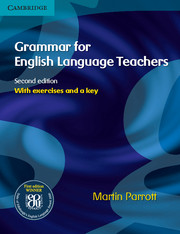21 - Sentence constituents: major variants
Published online by Cambridge University Press: 09 February 2023
Summary
Key considerations
Learners who have problems with the basic principles for ordering words and sentence constituents often want to develop a good command of these before they begin to try using most of the possible variants. However, if they are hearing and seeing natural English, they inevitably come across lots of examples which don’t follow the ‘basic’ rules.
Constructing questions is the one ‘variant’ that we can’t avoid teaching, and which we need to teach in the earliest stages. Native speakers of English sometimes take for granted the way we construct questions. In fact, this involves complicated changes to the order of words in clauses, and many learners develop a command of question forms only very slowly.
Learners who have a good level of English often welcome encouragement to vary the patterns and basic orders they use in order to achieve particular emphasis. This is particularly relevant to learners who need to write English.
What are the major variants? Question forms
In many languages the distinction between questions and statements is made only through intonation in speaking and punctuation in writing. However, in English, we use grammar to make this distinction (and often we don’t use any ‘special’ features of intonation at all).
We divide question forms into four kinds. Three of these depend on the type of verb phrase involved.
Type 1
These are verb phrases comprising am, is, are, was or were as a complement verb. We reverse the normal order of subject and verb. Are you ill? Was Dad at home.
Type 2
These include one or more auxiliary verbs (including modal verbs). We reverse the order of the subject and the (first) auxiliary verb.
Can Dad stay? Have you been drinking beer.
Type 3
These are single-word verb phrases (present simple and past tense of all main verbs apart from be). We introduce a ‘dummy’ auxiliary (do, does or did) to make the question.
Did you swim Do you take sugar
We sometimes refer to questions which begin with a verb as yes/no questions.
We can add question words such as why, how, where, where. to the beginning of questions which belong to Types 1–3.
- Type
- Chapter
- Information
- Grammar for English Language Teachers , pp. 315 - 329Publisher: Cambridge University PressPrint publication year: 2010



